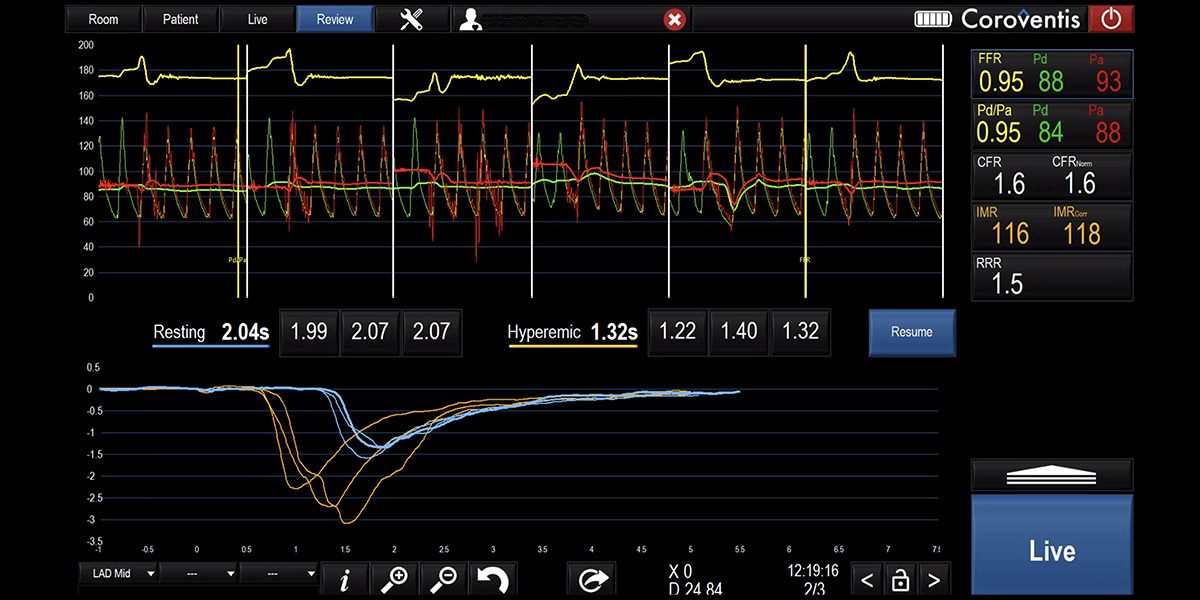Innovative New Technology Successfully Diagnoses Heart Disease in Small Blood Vessels at Hackensack University Medical Center
New Jersey’s first center with Abbott CoroFlow Cardiovascular System offers first conclusive diagnosis of microvascular disease

Coronary microvascular disease is a significant contributor to symptoms but has been difficult to objectively diagnose. Interventional cardiologists at Hackensack University Medical Center are the first in New Jersey to employ a novel method to comprehensively assess the health of epicardial (large) and microvascular (small) arteries in the heart and pinpoint disease, and thus develop patient-specific care plans.
Ankitkumar Patel, M.D., associate professor of Medicine/Cardiology, Hackensack Meridian School of Medicine, associate program director, Hackensack University Medical Center Interventional Cardiology Fellowship Program, and director of Mountainside Medical Center Cardiac Catheterization Laboratories, acknowledges the use of the Abbott CoroFlow Cardiovascular System during coronary angiography to comprehensively evaluate epicardial disease and microvascular dysfunction in people with symptoms such as chest pain and shortness of breath. Prior to this, patients would often present with ongoing symptoms and have a delay in comprehensive diagnosis and treatment.
In patients presenting with chest pain, about 50% show no large artery obstruction in the cath lab, but their symptoms can be related to small vessel obstruction. Until now, the only way to diagnose microvascular disease conclusively was to rule out other possibilities, as microvascular blockages cannot be detected on angiograms. The Hackensack University Medical Center team has already performed more than 125 cases with the new tool and is one of the highest-volume centers in the Northeast.
“The CoroFlow Cardiovascular System is a revolutionary diagnostic tool that’s only available at a handful of U.S. heart centers, including at Hackensack University Medical Center,” Dr. Patel said. “It allows us to conclusively diagnose coronary microvascular dysfunction caused by blockages in the heart’s smallest arteries.”
When properly diagnosed, drug therapies specific to small vessel dysfunction are available. But when misdiagnosed, patients may be treated instead for anxiety or acid reflux, for instance, or undergo repeated, inconclusive cardiac tests.
The system consists of a wireless device used with Abbott's PressureWire™ X Guidewire. It generates hemodynamic data measuring the function of the epicardial and microvascular vessels. It’s now integrated in comprehensive diagnostic protocols in the cath lab at Hackensack University Medical Center, when imaging fails to show large-vessel disease. The center also is providing microvascular disease assessment to a significant number of self-referred and regional physician-referred patients throughout the region with prior negative epicardial imaging.
CoroFlow diagnostic protocols and techniques are also now integrated in the center’s interventional cardiology fellowship training and will soon be presented in the center’s Department of Medicine grand rounds to raise awareness of this important new capability among primary care physicians.
Dr. Patel participates in the Microvascular Network, a select group of more than 50 physicians across North America established to support patient advocacy and awareness, clinical trials and collaboration, which is launching a patient registry to which Hackensack University Medical Center will contribute. The center also recently was one of a select few high-volume centers invited to join the multicenter Coronary Microvascular Disease Registry.
As New Jersey’s population is extremely diverse, he notes that Hackensack University Medical Center is an ideal exploration site to apply and study clinical innovations like the CoroFlow system in cardiovascular care and contribute to large-scale, national studies. Notably, microvascular disease occurs more often in women than men and likely is a significant contributor to disparities in cardiovascular care. Offering this new tool can help the team better study and serve these affected groups.
Learn more about innovative heart and vascular care at Hackensack University Medical Center.
If you are a patient looking for expert cardiovascular care at Hackensack Meridian Health, please visit our heart service page to learn about our specialties, find locations, and schedule appointments.
